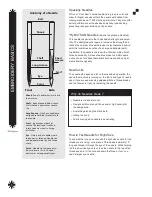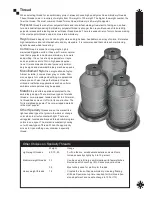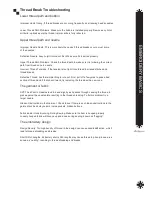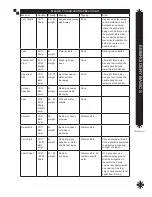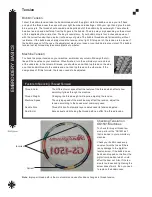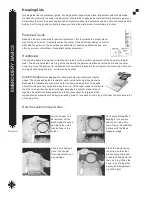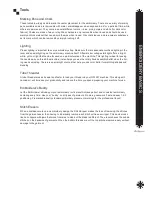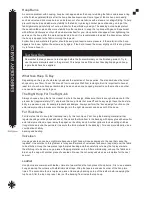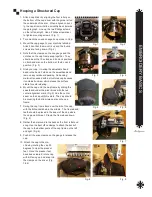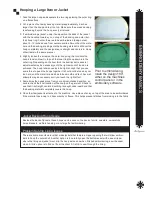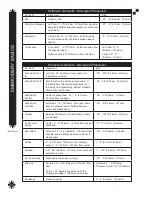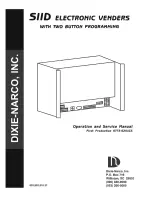
EM
BR
OI
D
ER
Y
B
AS
IC
S
17
Hoop Burns
A common problem with hooping, hoop burns happen when the hoop is rubbing the fabric and leaves a ring
on the finished garment/fabric after the hoop has been removed. Some types of fabrics hoop burn easily,
such as velvet and silk. Hoop burns can be taken out of some fabrics with a steamer or Magic Sizing. To help
prevent hoop burns and add more stability to the fabric, try placing another piece of backing on top of the
fabric/garment and carefully cut out a window for the embroidery design. The backing on top helps protect
the sensitive fabric plus adds more stability. Another option is to wrap the top hoop with gauze. Experiment
with different techniques until you find what works best for you. Hoop burns also appear from tightening the
screws on the hoop after the material is placed in hoop. It is recommended to adjust the hoop screw before
the hoop is applied to the fabric. Joining the top and
bottom hoop and materials together should be snug and require some pressure. If the material in the hoop
appears too loose, tighten the screw and try again. If too hard, loosen the screw slightly until it is snug. Never
try to force a hoop in.
What Size Hoop To Buy
Depending on the type of embroidery business the selection of hoops varies. The standard sizes that most
shops carry are 12cm, 15cm, 18cm and 21cm round plus 30x30cm rectangle. But it is important to have at
least two of each size hoop per embroidery head so when one hooped garment is on the machine, another
one can be hooped ready to go on.
The Right Hoop For The Right Job
Always choose a hoop that is the closest in size to the design. Make sure there is enough allowance for the
presser foot (approximately 1/2") all around the hoop. Items that are stiff and heavy weight have the best sta-
bility in a wooden hoop, for example jacket back designs. Always perform the “trace design” function on the
embroidery machine to make sure the design is in the right placement and does not hit the hoop.
For Thick Items
For items too thick to hoop the traditional way, try this technique. First, hoop the backing material (either
regular backing or sticky back adhesive). Then stick the thick item to the backing with spray glue adhesive (for
embroidery machines) or peel away the paper on the sticky back. Another option is to use basting stitches
(long stitches around the perimeter to secure the thick material to the backing). For even more stability, use a
combination of sticky
backing and basting.
Velveteen
Hooping velveteen can be a nightmare because a tight hoop will cause damage to the nap that cannot be
repaired. One solution to this problem is to lay another piece of velveteen face down (nap side) over the fabric
to be stitched. Hoop the two pieces together plus backing and then carefully cut away the top layer where
the stitching is to be done. Lay a piece of topping material on top. After embroidering, unhoop the fabric and
brush up the nap with another piece of velveteen. Re-use the cut-away velveteen as a template for the next
sew out.
Leather
Hoop burns are common with leather. Here are two methods that can prevent hoop burns. First, use a square
hoop and wrap the corners with athletic/medical tape. Wrap the tape around each corner of the hoop two
times. The second method is to place a piece of tear-away backing on top of the leather before applying the
top hoop. After the top hoop is set, tear out the backing from inside the top hoop.
Test Sew Outs
Remember to always sew out a test design before the final embroidery on the finished garment. Try to
use the same materials used in the garment. This helps to see if the correct backing/topping and hoop-
ing methods have bee applied.
Summary of Contents for GS1501
Page 30: ...GETTING STARTED 28 ...
Page 31: ...GETTING STARTED 29 The Control Panel Display ...
Page 62: ...EMBROIDERY BASICS 28 Notes ...
Page 64: ...MACHINE BASICS 2 ...
Page 65: ...MACHINE BASICS 3 ...
Page 70: ...MACHINE BASICS 8 ...
Page 71: ...MACHINE BASICS 9 ...
Page 78: ...MACHINE BASICS 16 Notes ...

